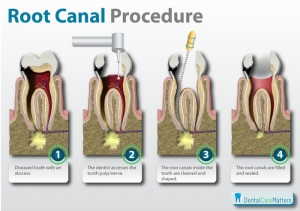Star of Texas Dental Assisting School is the best dental assisting school in Austin due to its advanced training and education practices. Students are taught through classroom and hands-on learning in a dental office setting. Our students have the ability to learn from dental specialists in Endodontics, Periodontics and Oral Surgery.
What are our students learning about Endodontic Assisting?
The pulp of your tooth, which contains the nerve and tiny blood vessels, can become infected. The pulp has a limited ability to heal itself. This infection can be caused by a deep cavity that reaches the center of the tooth causing the pulp to die, a traumatic injury to the tooth, or an extensive preparation (drilling) of the tooth. The extensive preparation may have been done to prepare the tooth for a crown (cap) or other large preparation for a restoration. The pulp may or may not abscess immediately in these cases. It may take years for a problem to develop. The infected pulp tissue may or may not be painful. It may or may not be visible on a dental radiograph. A tooth with this type of an abscess is not usually extracted because the infection can be treated with endodontic therapy on the tooth. This routine procedure can save the tooth and enable you to avoid the harmful effects of tooth loss. It is successful in more than 90% of the teeth in which the treatment is completed.
When it has been determined that the canals are free of infection, they are filled with a special rubber-like material and sealed with a cementing medium. The abscessed area associated with the tooth will then begin to heal. It may take several months before healing is completed and for the tooth to become asymptomatic, that is, for any soreness in the area to disappear. Endodontic treatment can take from one to three appointments to complete. Teeth can have one to four canals that need to be treated. An opening is created to access the nerve, and the abscessed nerve is removed from the root or roots. The canals where the nerves had been located are then cleaned and shaped and a medication may be placed in the canal to promote better healing.
Once the endodontic therapy has been completed, the tooth is usually restored with a cast crown or onlay. This is done to protect the tooth and prevent it from fracturing. Failure to follow through with mandatory restorative procedures after endodontic therapy on a previously uncrowned tooth can result in a vertical fracture. If there is very little tooth structure remaining, your doctor may also advise the use of a post and core to further help the tooth retain its final restoration. Your doctor will discuss restoration options specific to your needs.
Please note that this infection may cause discomfort between root canal appointments. This is normal and usually not a cause for any concern. Contact your office if there is pain and/or swelling. Remember to avoid biting down on the tooth until the root canal is completed and the final restoration has been placed. You may have had no discomfort from the tooth prior to the root canal treatment or have been unaware that you even had an abscess. However, you may experience pain or swelling after the root canal treatment has begun.
If you have been prescribed antibiotics for the abscess, be sure to fill the prescription and take it until it is finished. It is important that you do this in order to quickly control the infection. If you do not take the prescribed medication, the resolution of the abscess may be delayed and problems with the postoperative pain are more likely.
If you have any questions about the root canal procedure or the final restoration of the tooth, please feel free to ask us at (512) 487-1547. -Star of Texas Dental Assisting School


